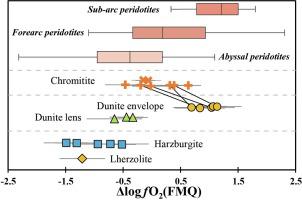Ore Geology Reviews ( IF 3.2 ) Pub Date : 2021-09-20 , DOI: 10.1016/j.oregeorev.2021.104483 Yuan He 1, 2 , Xiangkun Zhu 1 , Yuwei She 1 , Jianxiong Ma 1 , Jian Sun 1 , Zhaofu Gao 1 , Hongqing Wan 1 , Yuelong Chen 3

|
Although the mechanism of formation of podiform chromitite is debated, oxygen fugacity (fO2) is likely one of the controlling factors, although the detailed mechanisms are poorly understood. To provide insight into this issue, we determine the Fe3+/∑Fe ratio of chromite via Mӧssbauer spectrometry, and from this calculate the fO2 of chromitites, dunite envelopes, dunite lenses, and their host peridotites in the Luobusa ophiolite in southern Tibet. The fO2 (−1.49 to −0.52 log units relative to the fayalite–magnetite–quartz buffer) and mineral chemistry of the host peridotites are similar to those of both abyssal and forearc peridotites. Higher fO2 values of the dunites and chromitites (−0.65 to −0.33, 0.69 to 1.13, and −0.46 to 0.64 log units for the dunite lenses, dunite envelopes, and chromitites, respectively) relative to those of host peridotites must have been inherited from their parental magmas. Both chromite compositions and the fO2 of the dunites and chromitites are similar to those in boninite-like rocks. Importantly, there is a previously unrecognized but marked decrease in fO2 from the dunite envelopes to the chromitites. This decrease is intimately related to the chromitite-forming processes and preferably explained as the result of the exsolution of oxidized fluids from high-fO2 magmas during subduction initiation.











































 京公网安备 11010802027423号
京公网安备 11010802027423号